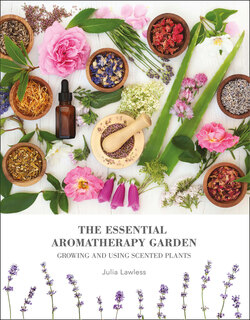Читать книгу The Essential Aromatherapy Garden - Julia Lawless - Страница 20
ОглавлениеSOME KITCHEN HERBS
In addition to the herbs listed in Chapter 7, there are a few other species to describe here that are especially valuable for their culinary and household applications.
DILL (Anethum graveolens) This is a hardy annual with attractive heads of golden flowers. Its leaves are similar to fennel and are delicious in salads and soups, as well as with fish. The seeds are very aromatic and can be used in wine vinegars or for pickling cucumbers and gherkins. They can also be steeped in water to soothe stomach upsets and hiccoughs.
BORAGE (Borago officinalis) This was a favoured herb of the ancient world. The Romans brought it to Britain and the Pilgrim Fathers carried it to New England in the early seventeenth century. Its leaves and flowers were steeped in wine to make a tonic – they are used today to flavour Pimms No.1. As its leaves and flowers have a mild cucumber fragrance, they are a pleasant addition to any cool drink in summer. The blue flowers are very decorative in green or fruit salads or floating on a fruit punch. They can also be candied. Borage is a hardy annual, easy to grow and self-seeds freely.
Borage (Borago officinalis)
emberiza
CHERVIL (Anthriscus cerefolium) This herb is popular in French cooking. It enhances the flavour of other herbs and is frequently used in bouquet garnis. Traditionally it is used in egg dishes and as a vegetable garnish. Its foliage is sweet, similar to aniseed. The plant has heads of white flowers and is a delicate annual that prefers light shade. Unlike dill, chervil seeds do not retain their germinating qualities for long and should be sown as soon as possible after ripening.
Chervil (Anthriscus cerefolium)
Oliver Hoffman
PARSLEY (Petroselinum crispum) This must be one of the most widely used of all culinary herbs. It is a hardy biennial, usually grown as an annual as its leaves are tough in the second year. Its seeds need moisture and warmth to germinate and the plant likes fertile soil, preferably in full sun or dappled shade. A tip to help encourage the seeds to germinate is to pour a kettle full of boiling water into the earth before planting. There are different varieties: some are flat leaved and some curly. Parsley seeds are used to make essential oils. Medicinally, parsley tea is diuretic and can be used to treat bladder and kidney infections. In the kitchen it is very versatile, for flavouring salads, soups and stews, and egg, fish and meat dishes – in fact virtually all savoury dishes.
SALAD BURNET (Sanguisorba minor) This plant is ideal for salads as the delicate foliage has a mild cucumber-like flavour. It is tasty with vegetables like asparagus or celery, and burnet leaves make an attractive garnish to a fruit salad or fruit cup. It is a decorative plant, too, for in sunshine the dull grey-green leaves take on a pink tinge. They last until the winter when they can also be used to flavour stews and sauces. Salad burnet grows very easily from seed and the summer flowers are green and purple.
Salad burnet (Sanguisorba minor)
picturepartners
SWEET CICELY (Myrrhis odorata) This is a delicate perennial herb. Its Latin name means literally ‘fragrant perfume’. The crushed unripe green seeds were once used extensively for polishing furniture as they have a fine, nutty anise-like aroma, and the plant is still used to make an essential oil used in perfumery work. Sweet cicely has light green, soft feathery leaves and umbels of white flowers, followed by distinctive long seed pods. It eventually reaches a height of about 1m (3ft) tall but dies down completely over winter. It is an attractive and useful addition to the kitchen garden: the sweet leaves can help to counteract acidity in fruits such as gooseberries or blackcurrants. They can also be used to flavour soups and omelettes.
Sweet cicely (Myrrhis odorata)
dabjola
SWEET WOODRUFF (Galium odoratum) A delightful plant for the kitchen garden, sweet woodruff is one of the few herbs that prefer shade. It is a low-growing perennial with small white flowers and, although it is not a culinary herb, it has many household uses. The fresh leaves of sweet woodruff were once hung from the ceiling to perfume and cool the air. It was also placed amongst bed linen to impart a fresh scent and was used in pot pourri. Its scent of new-mown hay comes from its coumarin content and is most pronounced when the plant is dried. It intensifies the longer it is kept. Sweet woodruff has moth-deterrent properties and in dried form can be placed between book pages to remove musty smells.
